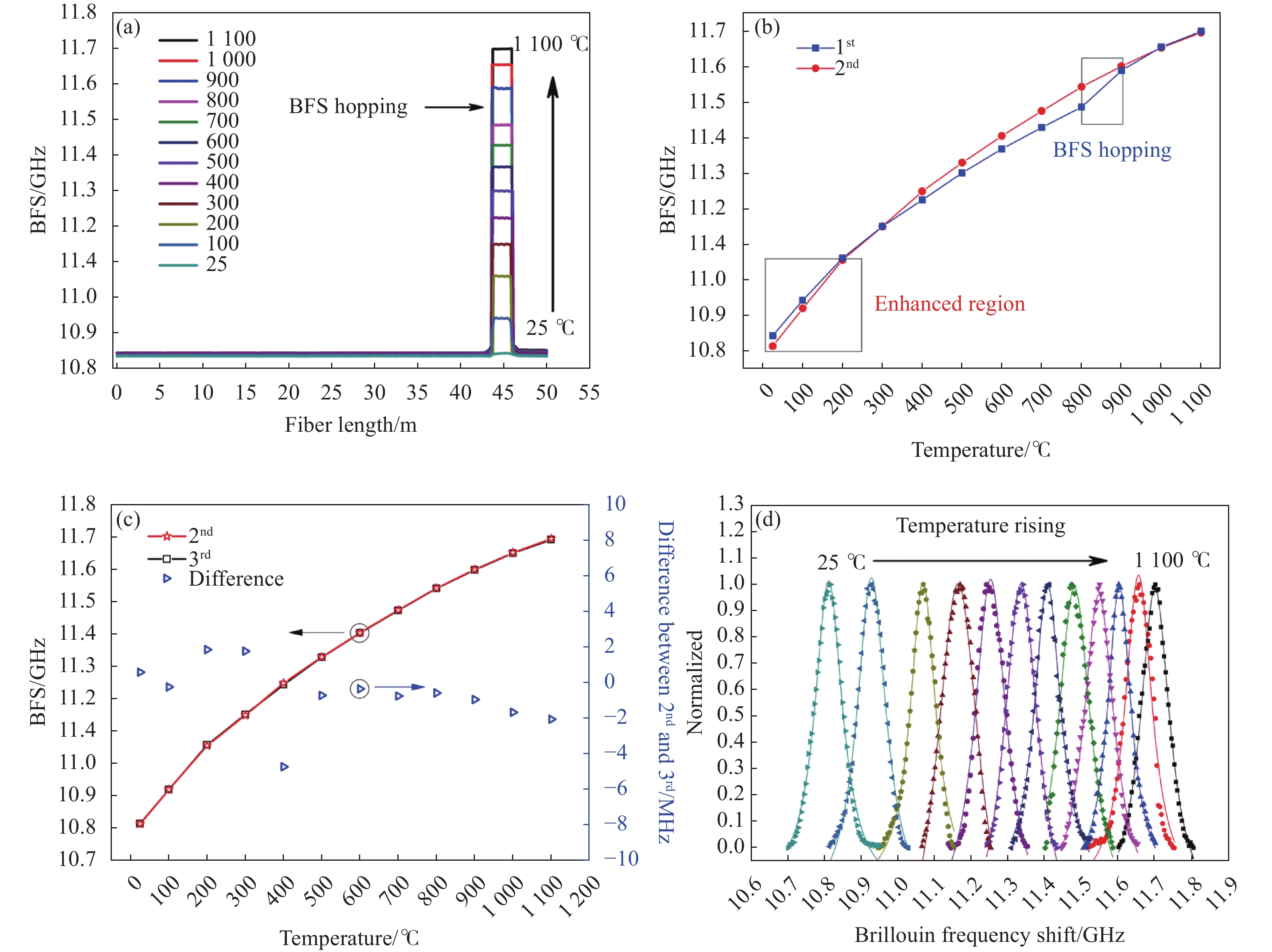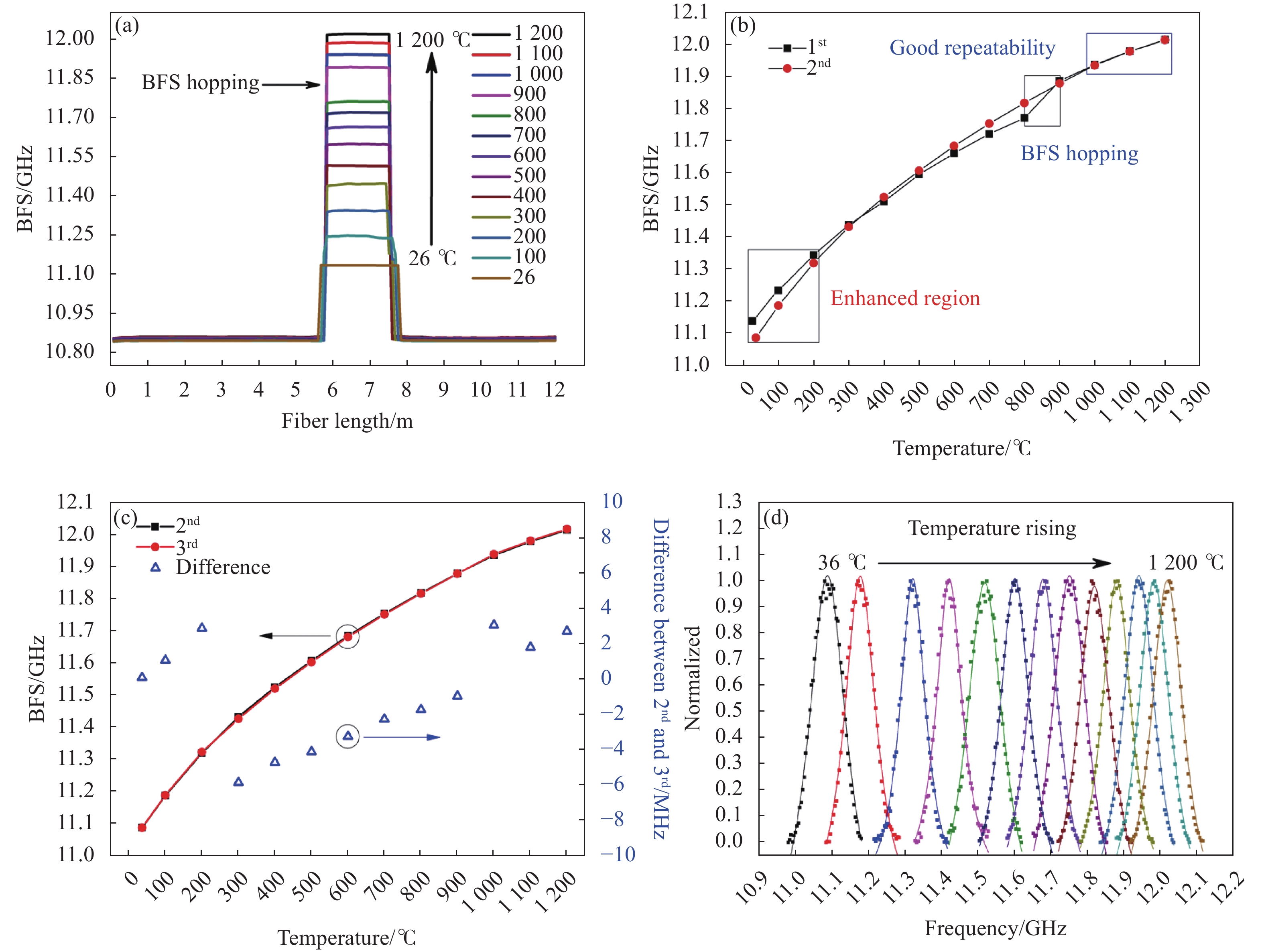-
工业生产、制造以及设备运行过程中常需要获取温度信息,对其进行监测是诸多领域研究人员关心的热点问题。特殊应用场合如发动机、涡轮机、变压器、核反应堆等[1-3]的高温监测环境伴有高压、辐射、腐蚀等问题,对传感器的性能提出了更高要求。
光纤传感器具备温度测量精度高、抗电磁干扰、抗腐蚀、耐辐射和体积小巧等优点,在高温监测领域体现出独特的优势[4]。分布式光纤温度传感器能够连续获取待测物体在空间上的温度分布信息,传感光纤本身既是传感器又是信号传输通道,具有测量距离长、范围广、点数多的优点,受到研究者们的广泛关注[5-6]。
分布式温度传感器主要包括基于拉曼散射的光时域反射计(Raman optical time-domain reflectometry, ROTDR)[7-9]和基于布里渊散射的光时域反射计/分析仪(Brillouin optical time-domain reflectometry/analysis, BOTDR/A)[10-11]。ROTDR测量原理简单,系统成本较低,是目前商业化程度较高的一种分布式测温技术,距离测量范围一般在30 km以下。BOTDA的距离测量范围可达上百千米,空间分辨率常为米级。相比于ROTDR,BOTDA测量精度高,在长距离温度测量方面具有一定优势[12-13]。
2003年,Luc Thévenaz等人报道了−272~727 ℃温度范围内单模光纤布里渊频移(Brillouin frequency shift, BFS)随温度非线性变化行为[14]。同年,李永倩等人研究了20~820 ℃温度范围内商用色散位移光纤的BFS对温度依赖性[15],并提出通过退火可以使光纤的BFS特性保持稳定且可重复。以上研究为实现基于布里渊散射的分布式光纤高温传感奠定了基础。2013年,Jing Wang等人基于BOTDA和单模光纤实现了1000 ℃的高温分布式传感[16]。但是该研究并未考虑光纤残余内应力的释放以及涂覆层燃烧对1000 ℃高温传感带来的影响。2016年,Yi Bao等人基于脉冲预泵浦BOTDA (PPP-BOTDA)测量了1000 ℃下熔融单模光纤的传感特性,研究了不同退火方式对传感器性能的影响[17]。纯二氧化硅的晶化温度Tg为1330 ℃,在石英光纤中加入掺杂剂将进一步降低Tg,说明石英光纤能存活的最高温度低于1330 ℃[18-19]。蓝宝石光纤具有高硬度和高熔点(约2053 ℃)[20],其在高温传感中有更强的生存能力。2016年,Bo Liu等人基于蓝宝石光纤和ROTDR技术实现了1200 ℃的分布式高温传感,测量标准误差为3.7 ℃[21]。
高温下,涂覆层为光纤提供气密性保护以防止氢入侵,在维持光纤机械特性方面扮演着重要角色[22]。但是高温环境下标准光纤涂覆层气化,导致裸光纤直接与空气接触。光纤中已经存在的慢裂纹缺陷扩展导致光纤机械强度大幅下降[23]。使用高熔点的金属涂覆层密封光纤可以使光纤维持原有机械强度,避免光纤疲劳,并且可以在金属熔点温度附近有效工作[24]。2017年,Ismail Laarossi等人基于标准光纤和镀金光纤通过ROTDR实现600 ℃的高温分布式传感[25]。该项研究工作采用了一种校准技术来消除光纤损耗波动带来的测量误差,但是对于镀金光纤来说,该技术需要在每个温度下进行重新校准,导致镀金光纤只能用于待测温度已知且热变化缓慢稳定的工业应用中。2019年,Ismail Laarossi等人对比了不同涂层(聚酰亚胺、铜、铝和金)光纤在高温下传感的优缺点,以及实验对比了基于ROTDR的最大温度为450 ℃分布式传感的精度以及可靠性[26]。高温下,镀金光纤的损耗随温度动态变化且不均匀分布,在ROTDR中会引起较大测量误差。基于频率检测的BOTDA可以避免镀金光纤损耗带来的波动影响。Rubén Ruiz-Lombera等人展示了基于镀金多模光纤和BOTDA的600 ℃下的分布式高温传感[27]。然而,该工作并未研究镀金光纤在600~1000 ℃的分布式传感特性。
文中基于BOTDA测量技术分别研究了单模光纤、光子晶体光纤和镀金光纤在1100 ℃、1200 ℃和1000 ℃的高温传感特性,通过对石英光纤的布里渊频移跳跃现象和涂覆层燃烧现象进行研究,并且对多次重复实验对比分析,指出石英光纤均需要退火才能够达到热稳定状态,退火需要温度在大于850 ℃下进行,并且冷却过程必须足够长以防止光纤中再次残余内应力。退火后,三种光纤的BFS随温度呈非线性变化;由于光纤中内应力的释放,在室温至200 ℃温度范围内三种光纤的温度系数都得到了提升。其中,单模光纤和光子晶体光纤高温状态下涂覆层气化,二氧化硅发生晶化导致其机械强度大幅下降,因此仅能作为一次性高温传感器;镀金光纤由于金涂层具有较高的熔点和良好的气密性,高温退火后仍然能够保持良好的机械强度,因此可以作为一种重复使用的高温传感器。
-
受激布里渊散射(Stimulated Brillouin scattering, SBS) 是一种光声相互作用现象,是泵浦光在电致伸缩效应下产生的驱动力与光纤中固有的声波发生共振的过程[28-29]。如果泵浦光和探测光的频率差在布里渊增益谱(Brillouin gain spectrum, BGS)的带宽内(石英光纤约为30 MHz),频率更高的泵浦光就会通过声波场将其部分能量转移到频率更低的探测光。
BOTDA 是基于泵浦-探测技术的双端注入系统,即泵浦光从一端注入光纤,探测光从另一端进入光纤产生SBS,通过扫描探测光的频率来改变泵浦光-探测光的频率差获得BGS,通过OTDR原理实现定位。BFS是石英光纤BGS的中心频率偏移,用于感测温度和应变。BFS公式如下[30]:
式中:
${n_{{\rm{eff}}}}$ 为光纤纤芯有效折射率;$ {v_A} $ 为声速;$ {\lambda _P} $ 为泵浦光在真空中的波长。温度传感由以下公式确定[31]:式中:
${C_{\rm{T}}}$ 为硅光纤的温度系数。通过测量硅光纤的BFS随温度的响应曲线,拟合曲线得到${C_{\rm{T}}}$ 。再通过测量热点区域的BFS变化量$ \Delta {v_B} $ ,通过公式(2)可以得到热点区域的温度变化量$ \Delta T $ ,从而获得沿光纤路径的温度分布。 -
BOTDA实验装置如图1所示。激光器输出光通过50/50 耦合器分为两路,上路为泵浦光,下路为探测光。任意函数发生器驱动电光调制器 (EOM) 产生泵浦脉冲,经扰偏器随机改变偏振态后被掺铒光纤放大器(EDFA)放大,然后进入待测光纤 (FUT)。探测光经过微波源驱动的EOM后被调制成载波抑制双边带信号光,通过隔离器后进入待测光纤。泵浦光和探测光的频率差满足待测光纤的BFS,在待测光纤中发生SBS。被放大的探测光由FBG滤出,通过光电探测器(PD)探测,并被示波器采集。通过扫描探测光的频率,将采集到的每个频率下的时域布里渊增益曲线重构获得三维BGS。通过对每一个光纤位置上的二维BGS进行洛伦兹拟合,提取出整条光纤的分布式BFS信息实现温度传感。

Figure 1. Experimental setup of BOTDA. (C, coupler; PC, polarization controller; EOM, electro-optic modulator; DC, direct current; AFG, arbitrary function generator; MG, microwave generator; PS, polarization scrambler; EDFA, erbium-doped fiber amplifier; FUT, fiber under test; FBG, fiber Bragg grating; PD, photodetector; OSC, oscilloscope)
待测光纤为单模光纤(Yangtze Ltd.)、光子晶体光纤(NKT photonics,LMA-10)和镀金光纤。实验中使用的泵浦脉冲宽度为 10 ns,对应于石英光纤中约 1 m 的空间分辨率。泵浦脉冲光的峰值功率约为400 mW,探测光的功率约为1 mW,导致信号强度相对较高。使使用箱式炉(上海钜晶有限公司,SXL-1400C)对待测光纤加热,其温度由测量精度为±1 ℃的热电偶监测。
-
该节对单模光纤的高温传感特性进行研究,通过逐一对比三次重复加热实验的测量结果,深入分析了退火前后单模光纤的稳定性和可重复性[32]。
将2.4 m长的单模光纤放入箱式炉中,以100 ℃为步长从室温加热至1100 ℃,重复三次测量。第一次实验结果如图2(a)所示,单模光纤的布里渊频移随温度非均匀增加,且在800~900 ℃范围出现大幅度增加,称为“BFS跳跃”。然后,箱式炉在10 h内冷却至室温后进行了第二次高温实验。图2(b)对比了第一次和第二次的实验结果,两次实验结果分别用蓝色方点和红色圆点表示,第二次实验中观察到BFS跳跃现象消失,且BFS随温度非线性均匀增加。第一次高温加热过程称为“退火”。退火后,室温至200 ℃单模光纤的温度系数得到增强,第一次和第二次实验的温度系数分别为1.246 MHz/℃和1.387 MHz/℃。最后,图2(c)对比了第二次和第三次实验结果,图中蓝色三角形表示两次实验的差值,两次实验的BFS随温度都呈非线性增加,展现出良好的重复性,由于箱式炉内温度存在波动,除了400 ℃之外,两次实验的BFS差值都在±2 MHz之内变化。在25~1100 ℃每个温度点测量得到的BGS如图2(d)所示,实线表示通过洛伦兹函数拟合得到的洛伦兹拟合曲线,可以看出拟合结果和测量结果重合度较高。在1100 ℃下,单模光纤可以保持32 h没有产生额外的损耗。然而,当箱式炉温度达到1200 ℃时,单模光纤在短时间内损耗迅速增加,这是由于纤芯的掺杂离子扩散运动改变了其波导结构;同时,高温下光纤发生晶化也是损耗迅速增加的原因[19]。

Figure 2. (a) Distributed high temperature measurement results of 50 m long SMF sensing fiber; (b) Comparison of the first and second measurement results; (c) Comparison and difference of the second and third measurement results; (d) Brillouin gain spectrum measured after annealing in the temperature range of 25-1100 ℃
单模光纤需要通过一次退火来释放内应力使光纤达到稳定,但是在1000~1100 ℃范围,无需退火就表现出良好的重复性,可以有效工作。退火后,单模光纤在整个温度范围都展现了良好的重复性,BFS随温度呈非线性变化。在室温至200 ℃温度范围,退火后单模光纤的温度系数增强了约11.3%。
-
该节对光子晶体光纤的高温传感特性进行研究。通过对三次重复加热的实验逐一对比,深入分析了退火前后光子晶体光纤的稳定性和重复性[32]。
使用单模光纤跳线与约2 m长的全内反射型光子晶体光纤熔接,将光纤放入箱式炉中以100 ℃为步长从室温重复三次加热至1200 ℃。第一次实验结果如图3(a)所示,光子晶体光纤的BFS非均匀增加,在800~900 ℃区间也出现了BFS跳跃现象。然后,控制箱式炉在10 h内冷却至室温后进行第二次高温实验。图3(b)对比了第一次和第二次的实验结果,在第一次退火后,BFS跳跃现象消失,且BFS随温度均匀非线性增加。在室温至200 ℃范围,退火后的光子晶体光纤的温度系数得到了增强,两次实验的温度系数分别为1.18 MHz/℃和1.42 MHz/℃。此外,在1000~1200 ℃温度范围内两次测量结果重合度很高,表现出良好的可重复性。图3(c)对比了第二次和第三次实验结果,图中蓝色三角形表示两次实验的差值, 两次实验中BFS随温度都是非线性增加,展现出良好的重复性,由于箱式炉中的温度存在波动,除了300 ℃和400 ℃之外,两次实验的BFS差值都在±4 MHz内变化。在36~1200 ℃温度范围,每个温度点的布里渊增益谱如图3(d)所示,实线表示洛伦兹函数拟合曲线,可以看出拟合结果和测量结果重合度较高。

Figure 3. (a) Distributed measurement results of Brillouin frequency shift on photonic crystal fiber; (b) Comparison diagram of the first and second BFS measurements; (c) Comparison and the difference between the second and third measurements; (d) Brillouin gain spectrum measured after the first annealing in the range of 36-1200 ℃
通过对比单模光纤的高温测量结果可知,光子晶体光纤具有规则六边形晶格结构,由于排除了掺杂离子扩散的影响,可以实现高达1200 ℃的分布式高温传感。然而光子晶体光纤在1200 ℃下仅保持约3 h,随后损耗迅速增加,约为2.4 dB/m,表明光子晶体光纤正逐渐晶化,波导结构正在被持续破坏。光子晶体光纤需要通过一次退火来释放内应力使光纤达到稳定。在1000~1200 ℃温度范围,无需退火就表现出良好的重复性。退火后,光子晶体光纤在整个温度范围都展现了良好的重复性,BFS随温度呈非线性变化。在室温至200 ℃温度范围,退火后光子晶体光纤的温度系数增强了约20.3%。
-
该节研究BFS跳跃现象以及涂覆层燃烧对高温测量的影响。实验中,将约10 m长的单模光纤被放入箱式炉中加热,分别在800 ℃、850 ℃和900 ℃保持2 h,温度每升高50 ℃需要20 min来达到稳定的温度场。黑色方点表示BFS测量结果,红色圆点表示每个相邻温度测量点的BFS差值,如图4(a)所示,800 ℃期间内,BFS在2 h内几乎没有变化,保持稳定,表明BFS跳跃在该温度下没有发生[33]。接下来,箱式炉升温至850 ℃,可以看出前40 min BFS大幅度增加,然后增长速度减慢,表明在该温度下发生了BFS跳跃,值得注意的是,在图2(b)中观察到1000 ~1100 ℃温度范围第一次与第二次实验的测量结果基本吻合,表明BFS跳跃带来的影响在1000 ℃之前已经完全消失。光纤中残缺内应力的释放会导致BFS出现大幅度增加,出现BFS跳跃现象,它是一种与温度高度相关的行为。
随后,研究了发生在BFS跳跃之前的温度区域(100~800 ℃)的单模光纤的稳定性。如图4(b)所示,单模光纤从100 ℃重复两次加热至800 ℃,两次实验的测量结果由黑色方点和红色圆点表示,蓝色三角形表示两次实验的BFS差值,两次实验结果重复性良好,BFS差值基本都在±4 MHz内变化。由于涂覆层燃烧导致300 ℃和400 ℃的BFS差值大于4 MHz。单模光纤和光子晶体光纤的涂覆层均由厚度为125 µm的丙烯酸脂构成,这种材料不耐受高温,在300~400 ℃会燃烧。涂覆层燃烧引起的压应力产生BFS响应,导致涂层燃烧期间的BFS差异。此外,涂覆层燃烧会使光纤累计应力产生微弯曲[34],光纤产生微弯曲会使信号产生损耗,在一定程度上导致BGS产生拟合误差。
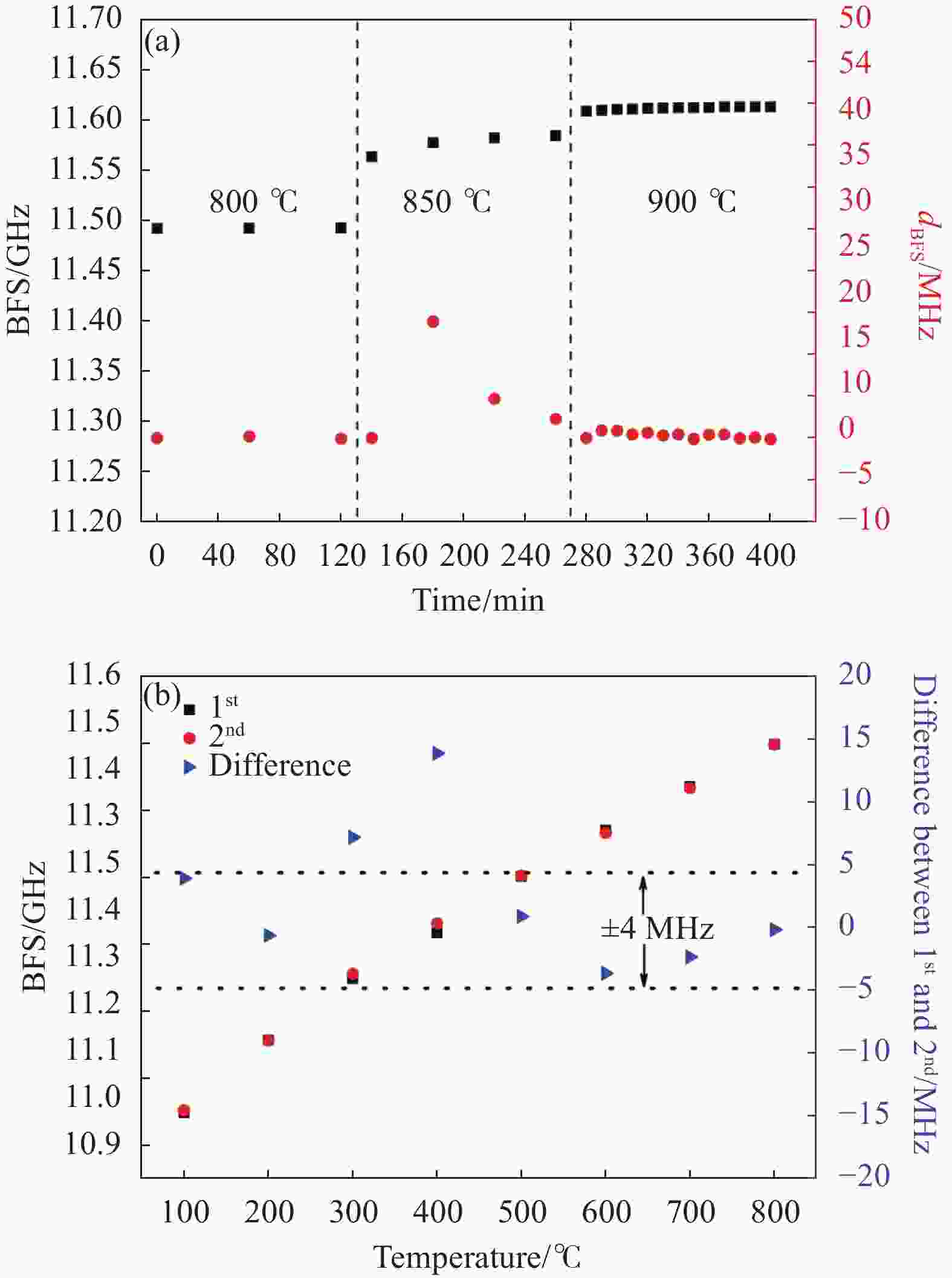
Figure 4. (a) Investigation of BFS hopping; (b) Comparison of two measurements under temperature region of BFS hopping
BFS跳跃和涂覆层燃烧会给高温测量带来较大的影响。同时,由于高温下缺少涂覆层保护,裸光纤与空气中水分子接触容易导致光纤疲劳,大大降低了光纤的机械强度,使传感器可靠性降低[23]。
-
该节对镀金光纤的高温传感特性进行研究,通过分析镀金光纤重复五次高温测量实验结果,研究在室温至1000 ℃镀金光纤的稳定性和可重复性[35-36]。值得注意的是,测量镀金光纤BFS的实验装置为基于差分脉冲对的BOTDA[37](DPP-BOTDA),空间分辨率为 20 cm;镀金光纤为1 m长的镀金单模光纤 (FiberGuide AFS 9.0/125/155G) 。
镀金光纤以50 ℃的步长从室温重复五次加热至1000 ℃,如图5(a)所示。图5(b)展示了前后两次测量结果的做差结果,黑色列表示第二次与第一次实验结果差值,由于在第一次退火过程中内应力得到释放,可以观察到其BFS差值先增大后减小,在700 ℃时BFS差值达到最大,为30 MHz。图5(b)的红色列表示第二次和第三次的BFS差值,即使考虑了箱式炉温度波动带来的影响,在350 ℃之前其BFS差值都大于10 MHz,说明第一次退火后镀金光纤还未达到稳定状态。蓝色列和粉色数据表示的BFS差值在300 ℃之后都在±2.5 MHz内波动,说明镀金光纤在退火两次之后达到了相对稳定的状态,且BFS随温度的变化为非线性函数。将第三次测量得到的BFS随温度变化用于多项式拟合:
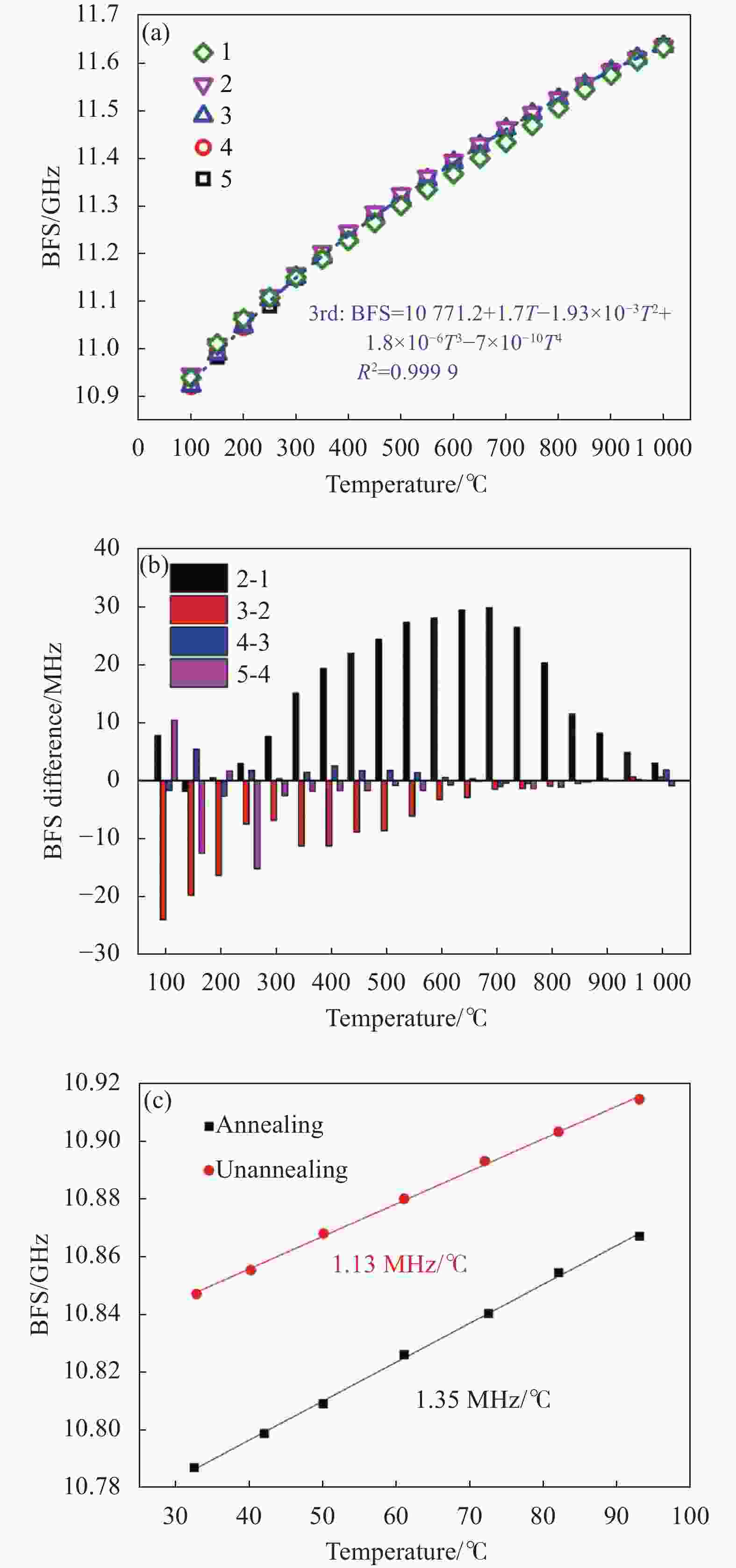
Figure 5. (a) BFS results of 5 measurements at a single sensing point in steps of 50 ℃ from 100 ℃ to 1000 ℃; (b) Comparison diagram of BFS difference between two adjacent measurements with temperature change; (c) Comparison diagram of temperature coefficient from room temperature to 90 ℃ before and after annealing
式中:
${v_{{\rm{BFS}}}}$ 为光纤布里渊频移;T为温度。如图5(c)所示,经过两次退火后,在30~100 ℃范围内镀金光纤的温度系数提高。在单模光纤和光子晶体光纤中同样观察到这种现象。由于金涂覆层的保护,镀金光纤中的二氧化硅很难与高温环境中的水分子作用,使得退火后的镀金光纤可以保持与退火前几乎相同的机械强度,表明镀金光纤可以在高温下重复测量。 -
基于BOTDA测量技术分别研究了单模光纤、光子晶体光纤和镀金光纤在1100 ℃、1200 ℃和1000 ℃的高温传感特性。三种光纤经过退火后达到稳定,BFS随温度非线性变化。BFS跳跃和涂覆层燃烧对高温测量影响较大,通过退火可以消除这种影响。但是,退火后涂覆层气化,裸光纤在高温下与空气或水分子接触发生晶化,光纤的机械强度大大降低。故单模光纤和光子晶体光纤只能作为一次性传感器。镀金光纤由于金涂层具有较高的熔点和良好的气密性,高温退火后仍然能够保持良好的机械强度,因此可以作为一种重复使用的传感器。该研究有望为高温传感应用(如涡轮发动机内部温度监测)提供一种技术参考。
Distributed fiber high-temperature sensing based on BOTDA (invited)
doi: 10.3788/IRLA20220549
- Received Date: 2022-08-05
- Rev Recd Date: 2022-09-07
- Available Online: 2022-11-02
- Publish Date: 2022-10-28
-
Key words:
- distributed optical fiber high-temperature sensing /
- Brillouin optical time-domain analysis (BOTDA) /
- photonic crystal fiber (PCF) /
- gold-coated fiber
Abstract: In this paper, the high temperature sensing properties of single-mode fiber, photonic crystal fiber, and gold-coated fiber at 1100 ℃, 1200 ℃, and 1000 ℃ were studied based on Brillouin optical time-domain analysis (BOTDA). The fact of Brillouin frequency shift (BFS) hopping and the coating burning indicated that the silica fiber should be annealed to reach a thermally stable state. After annealing, the BFS of the three kinds of fibers increased with temperature nonlinearly. The coating of single-mode fiber and photonic crystal fiber burned at high temperatures. And the crystallization of silicon doped its mechanical strength, indicating that it can only be used as a one-time high-temperature sensor. The gold-coated fiber with a higher melting point and better hermeticity can maintain good mechanical strength after high-temperature annealing, so it is a reusable high-temperature sensor. The research in this paper showed the potential for high-temperature sensing applications such as temperature monitoring of turbine engines.



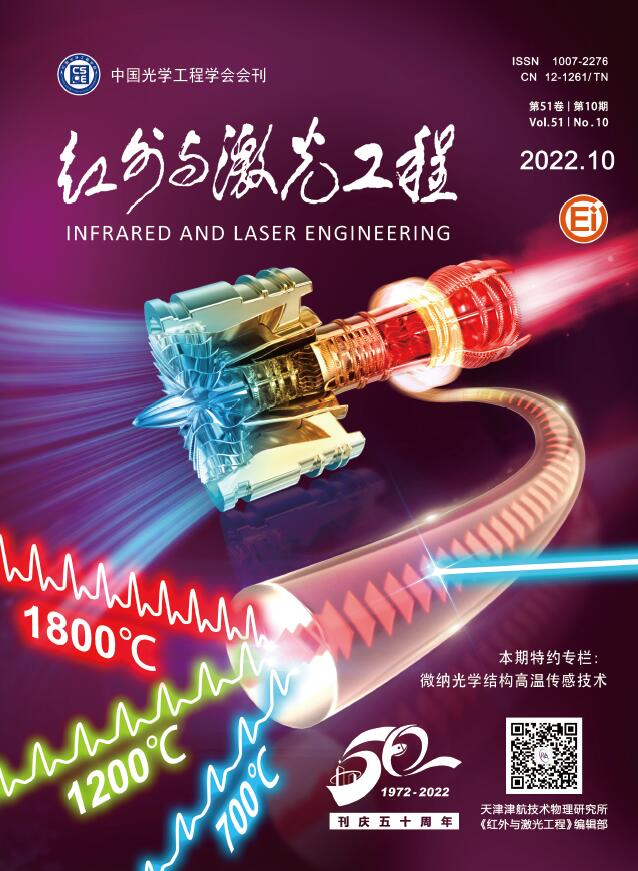














 DownLoad:
DownLoad:
